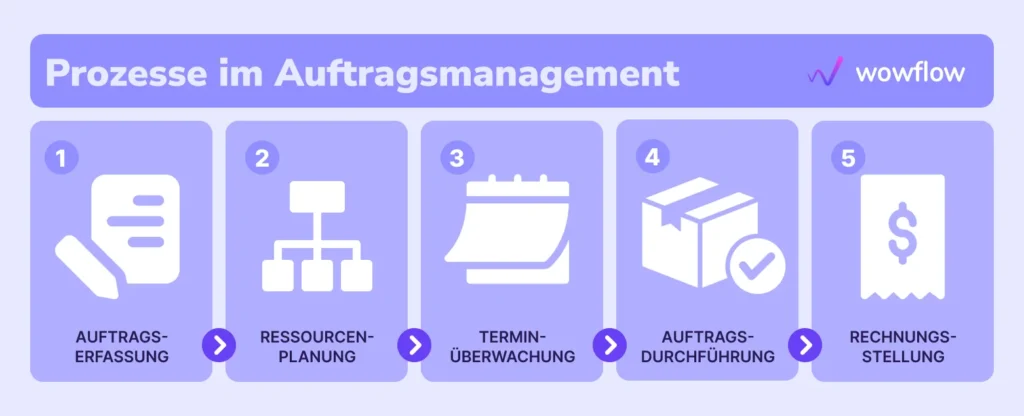Whether it’s a small workshop or a large shopping centre: missed deadlines, lengthy processing or angry customers – are all signs of inefficient order management.
But what is an effective order management system? Which core processes are of top priority?
This article explains the importance of order management optimization and provides specific tips to help you optimize your order processing.
What is order management?
Order management is the coordination and processing of work orders in a structured way.
Through various processes, it ensures that all steps, starting from order creation and work order management, through order processing and right to delivery of the finished product or service, are done on time, using minimum resources.
Why is order management so important?

Does this sound familiar? As soon as you start receiving more orders for products or services, you start losing track of all events and their due dates.
Important information gets forgotten, deadlines are missed and issues start piling on. This is precisely the moment where professional order management can help you out.
Structured order management ensures that all jobs go smoothly and are completed on time. It is a way to preserve resources by using them optimally, and manage even large orders without delays. With organized order processing, you are always in control. Customers are satisfied and your business continues to run smoothly.
Order management types
In practice, orders can be divided into different types. Each order type requires a different approach to planning and processing. The ideal order management system is adapted to the circumstances, specific to your companies business practices.
In principle, orders or assignments can be divided into two categories:
- Internal orders: which include all contracts within a company, for example in facilities management, this would mean maintenance, inspection or repair work, carried out at the company’s own site.
In facility management, the annual planning of maintenance with the corresponding technicians, spare parts and tools is an integral component of order management. Maintenance plan templates can be used to optimize this process. Keeping proper order documentation is crucial for maintenance purposes. Utilizing a maintenance log is the best practice in this scenario.
- External orders: those are, among others, customer orders. For example: a cleaning company is commissioned by various homeowners to clean their apartments.
These are classic customer orders that a cleaning company has to process. Order management coordinates customer appointments to avoid conflicting schedules and to minimize staff waiting times. The order of the apartments to be cleaned is therefore determined, tasks are planned and personnel assigned.
- Building management: An exciting part of facilities management
- Technical facility management: Planning, monitoring and maintenance in FM
The tasks of order management
Efficient order management includes steps like recording and tracking orders, planning resources, monitoring deadlines and invoicing.
This process enables optimum capacity usage, quick delivery times and increased customer satisfaction.
Order management software and 5 of its advantages
Regardless of the industry in question, an order management system can be beneficial for any company handling work orders on a regular basis.
We have listed the five key advantages of order management software.
1. Increased efficiency through automation
An order management tool automates many routine processes. Tasks as well as the availability of tools and materials can be tracked and recorded digitally, allowing you to handle all the processes in accordance to a specific set of rules.
Time-consuming manual activities are eliminated, and adherence to deadlines and budgets can be continuously monitored. Overall, with the right software, automation leads to greater efficiency, transparency and a higher level of control over your order management.
With the order management software from Wowflow, you can receive automatic notifications in case an order is delayed.
2. Inventory control

A task management app allows you to check whether the necessary materials and tools are available for upcoming work at any given time. The software automatically warns of potential time or resource bottlenecks and makes it easier to change around your schedules to avoid any delays.
All participating employees have access to the current tools and materials in stock and can place a request when needed. The precision in inventory management achieved through order management ensures complete transparency in regard to the utilized resources. This avoids supply bottlenecks and enables on-time processing.
3. ERP and CRM systems integration
A special order management system is the extension of your ERP system functionality. It serves as an order data source and is flexible enough to be easily integrated into systems that are already being used.
Thanks to the seamless integration into existing CRM systems, key customer data can be easily accessed through the order management software. This means that all customer order related communication processes and documents are stored centrally.
Wowflow can be integrated into your standard software such as ERP, CMMS or CAFM for a perfect end-to-end solution. Start today!
- BIM software: Efficient planning, implementation and management of construction projects
- CAFM: Holistic management of real estate and buildings
- CMMS: Software for maintenance processes optimization
4. Real-time monitoring and reporting
Digital order management enables real-time monitoring and reporting. This gives you an overview of order status and progress at all times.
Orders, resources and costs can be monitored in real time on various dashboards. This enables early detection of deviations and quickly responding to them. Regular reports provide a foundation for orders analysis to increase efficiency at any given time.
5. Increased customer satisfaction
Through end-to-end digitalization leading to an interconnection of all processes, a company can provide customers with transparent and up-to-date information on their order processing status. Errors can be avoided through automation and regular overview.
Adherence to deadlines and the smoothness of order processing lead to a positive effect on customer satisfaction.
Order management in 3 different industries: process comparison

The focus of order management can vary depending on the industry, because every process has to address different key areas. Next, we would like to tell you about the challenges and software solutions for order management from 3 different industries.
Order management in facilities management
Challenges:
The main task of order management in FM is the coordination of different services provided, such as building cleaning, maintenance and repair, servicing and security, which help maintain the building in a better condition.
Work orders can be considered as an integral part of asset management.
Cooperation with FM teams and service providers can be difficult to coordinate. In addition, maintenance measures and other tasks must be traceable in the event of an inspection.
For greater transparency and professionalism, customers receive reports on the various tasks carried out in the building.
- Predictive maintenance: the key to less downtime and greater efficiency.
Important functions:
The key feature is a real-time overview of all orders, effective planning of all measures and services, digital status documentation and effective communication with customers and service providers.
Software solutions:
Wowflow is a simple software solution that covers the most important challenges of FM.
With Wowflow, you can easily assign tasks to your FM teams and service providers with specific information and due dates. All orders can be tracked in real time. The calendar view is particularly useful for planning all work and recurring maintenance tasks in advance.
Wowflow also offers extensive documentation options. You can create professional reports automatically and share them with your customers immediately. The PDF contains all relevant data and can be digitally signed.
Order management in the transportation industry
Challenges:
Order management in the transportation industry has to help plan efficient routes for the transportation and delivery of goods. Aspects such as vehicle scheduling, adherence to delivery times and location tracking must be taken into account.
Important functions:
Central to this are the options for digital route planning, real-time vehicle tracking and the digitalization of all accompanying documents and delivery slips.
Software solutions:
Routecontrol’s software solution offers attractive functions such as route optimization, direct driver communication via app and real-time vehicle tracking.
Order management in warehousing

Challenges:
The precise recording of incoming and outgoing goods and the complete documentation of inventory and stock movement are central to warehouse order management.
Precisely monitoring best-before dates and compliance with them must be ensured by order management. It is also important that specific storage requirements such as separate areas, storage temperatures or other parameters can be flexibly configured and monitored to ensure the quality of products.
Important functions:
The storage of warehouse and order picking information, interfaces to retail systems for the exchange of goods and complete traceability are vital.
Software solutions: Oracle offers specialized order management solutions for the warehouse logistics industry.
Conclusion
Efficient order management is characterized by a consistent process structure, clear responsibilities and early resource planning. Only those who precisely control and coordinate all steps from order entry to processing can ensure that deadlines are met and operations run smoothly.
Effective order management is therefore the key to customer satisfaction and optimized use of resources in any industry.
Keep your order management under control with Wowflow. Get started today!
FAQ
What is the difference between order management and project management?
Order management coordinates recurring, similar orders such as customer orders or maintenance orders. The focus is on efficient, standardized processing in real time.
Project management, on the other hand, plans and controls more complex, time-limited projects. Budgetary and time constraints as well as risk minimization also come into play here.
While order management tends to optimize processes, project management analyzes the framework conditions of entire projects.
In summary, order management focuses on ongoing operational processes, while project management focuses on the holistic handling of individual projects. Both are important management functions.
How can customers be integrated into the order management process?
A customer portal keeps customers continuously informed about the status of their orders. A feedback function after order completion also contributes to transparency and customer satisfaction.
What are the key figures for controlling orders?
Important key figures are incoming orders, order throughput times, costs per order, adherence to delivery dates and customer satisfaction. This allows efficiency to be measured and improved on an ongoing basis.




